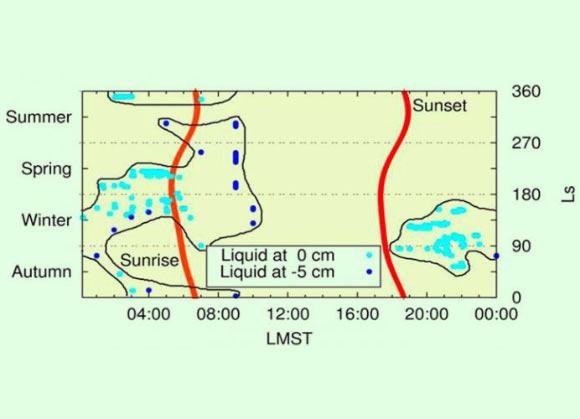An international team of scientists, led by Dr Javier Martin-Torres of the Spanish Research Council in Spain and the Lulea University of Technology in Sweden, has analyzed humidity, air temperature and ground temperature data from NASA’s Curiosity Mars rover at Gale crater, and found that the observations support the formation of night-time salty brines in the uppermost 5 cm of the subsurface that then evaporate after sunrise.

Gale crater is 155 km in diameter and now holds a layered mountain rising about 5 km above the crater floor. This illustration depicts a lake of water partially filling the crater. Image credit: NASA / JPL-Caltech / ASU / UA / Sci-News.com.
“We have discovered calcium perchlorate (an inorganic compound capable of lowering the water’s freezing point and absorbing water vapor from the atmosphere) in the Martian soil,” said Dr Morten Bo Madsen of the University of Copenhagen’s Niels Bohr Institute, a co-author of the study published in the journal Nature Geoscience.
Calculations made by Dr Martin-Torres, Dr Bo Madsen and their colleagues indicate that conditions at the Curiosity’s near-equatorial location were favorable for small quantities of brine to form during some nights throughout the year, drying out again after sunrise.
Conditions should be even more favorable at higher latitudes, where colder temperatures and more water vapor can result in higher relative humidity more often.
“Our measurements from the Cuirosity’s Rover Environmental Monitoring Station (REMS) show that these conditions exist at night and just after sunrise in the winter,” Dr Bo Madsen said.
“When night falls, some of the water vapor in the atmosphere condenses on the planet surface as frost, but calcium perchlorate is very absorbent and it forms a brine with the water, so the freezing point is lowered and the frost can turn into a liquid.”

The red line on the left shows the sunrise and the right is the sunset; when night falls, some of the water vapor in the atmosphere condenses on the planetary surface as frost, but perchlorates are very absorbent and it forms a brine, which is liquid; the light blue dots show when a brine with calcium perchlorate is liquid at the surface and the dark blue dots show when it is liquid 5 centimeters below the surface. Image credit: Javier Martin-Torres et al.
He added: “the soil is porous, so what we are seeing is that the water seeps down through the soil. Over time, other salts may also dissolve in the soil and now that they are liquid, they can move and precipitate elsewhere under the surface.”
“We have not detected brines, but calculating the possibility that they might exist in Gale crater during some nights testifies to the value of the round-the-clock and year-round measurements REMS is providing,” said co-author Dr Ashwin Vasavada of NASA’s Jet Propulsion Laboratory in Pasadena.
“Liquid water is a requirement for life as we know it, and a target for Mars exploration missions. Conditions near the surface of present-day Mars are hardly favorable for microbial life as we know it, but the possibility for liquid brines on Mars has wider implications for habitability and geological water-related processes,” concluded Dr Martin-Torres, the lead author on the study.
_____
Martin-Torres F.J. et al. Transient liquid water and water activity at Gale crater on Mars. Nature Geoscience, published online April 13, 2015; doi: 10.1038/ngeo2412







